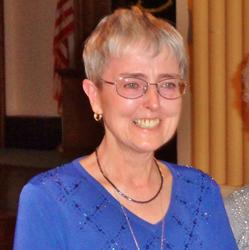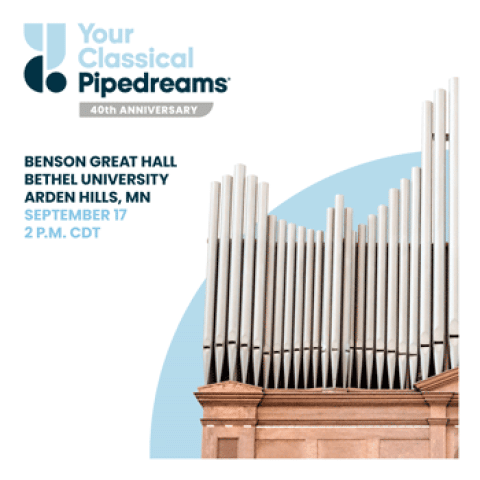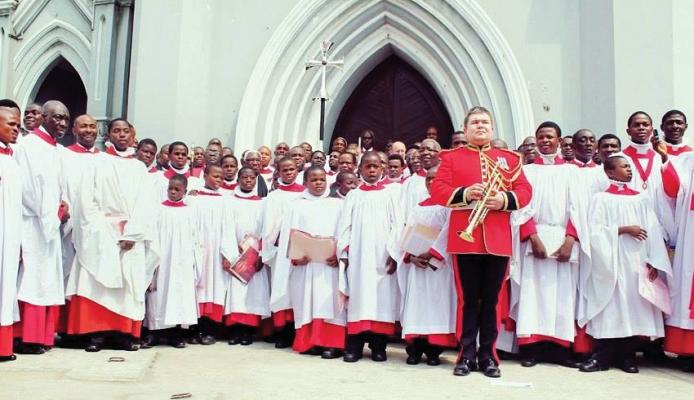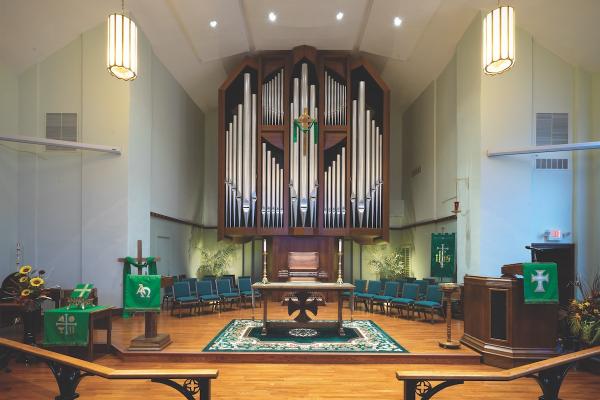Jennifer Lucy Bate, 75, born in London, UK, November 11, 1944, died March 25. She was the daughter of H. A. Bate, organist of St James’s Muswell Hill from 1924 to 1978. An international concert organist, she was considered an authority on the organ music of Olivier Messiaen, having befriended him within the last twenty years of his life as his organist of choice. In 1986, she gave the first British performance of his Livre du Saint-Sacrement at Westminster Cathedral and later made the world premiere recording of the work under the personal supervision of the composer, winning the Grand Prix du Disque. He also endorsed her earlier recordings of all of his other organ works. Bate owned scores that contain many personal markings and references made by Messiaen. In 1995, Bate opened the Messiaen Festival at l’Église de la Sainte Trinité, Paris, France, where his complete organ works were performed and recorded. Among numerous awards for her CD were the Diapason d’Or (France) and Preis der Deutschen Schallplattenkritik (Germany).
Bate performed and recorded a broad repertoire spanning several centuries, including English organ music, the complete organ works of César Franck, and the complete organ music of Felix Mendelssohn. A frequent performer at organ festivals, she often played works written for her. She also presented numerous masterclasses and lectures. She was instrumental in the formation of the annual Jennifer Bate Organ Academy, a course for young female organists, and she was the lead patron of the Society of Women Organists.
Bate was briefly married (as his second wife) to George Thalben-Ball. She received an honorary doctorate from the University of Bristol in 2007. In 1990, Bate was recognized with the Personnalité de l’Année award by the French-based jury, only the third British artist to achieve this distinction, after Georg Solti and Yehudi Menuhin. In 1996, Bate was granted honorary citizenship of the Italian province of Alessandria for her services to music in Northern Italy over 20 years. In 2002, she was elected a Fellow of the Royal Society of Arts, and in 2008 was appointed Officer of the Order of the British Empire.
In 2011, M. Frédéric Mitterand, minister of culture and communication, awarded Jennifer Bate the rank of Officier de l’ordre des Arts et des Lettres, stating that this honor is awarded to renowned artists and writers who have promoted French culture throughout the world. Subsequently, President Sarkozy appointed Jennifer Bate to the rank of Chevalier in the Ordre National de la Légion d’Honneur, stating that this honor was awarded in recognition of her skill as an organist and her contribution to making Olivier Messiaen’s organ works more widely known throughout the world. She received both awards in 2012.
Marillyn Ila Freeman, 85, musician and teacher, died March 24. Born in Marion, Wisconsin, February 23, 1935, she grew up in New London and Appleton, where she began playing the organ for local church services at the age of twelve. She graduated from Appleton High School in 1953 and the Lawrence College Conservatory of Music, Appleton, earning a degree in music performance in 1957. While at Lawrence, she met her future husband Ralph Freeman, and they were married in 1958. Following graduation Freeman taught music at Lawrence and worked in the president’s office at Princeton University, eventually returning to Wisconsin and settling in Green Bay, where she taught piano and played organ in the Moravian church.
In 1965 the Freemans moved to Neenah where a year later she began a 54-year career as organist for St. Paul Lutheran Church. In addition to playing organ and piano, as director of music ministries she planned worship services, directed youth choirs, accompanied the adult Sanctuary Choir, presented church musicals, and guided the church in purchasing a new Dobson organ in 1986. She earned an associate certificate of the American Guild of Organists in 1995 and an associate in music ministry certificate in 2000.
Throughout her career Freeman continued to teach piano and organ, organizing piano recitals, judging piano competitions, and mentoring young musicians in the Fox Valley. She was a member of the Fox Valley Music Teachers, a member of the Sigma Alpha Iota International Music Fraternity, served as treasurer of the North Eastern Wisconsin chapter of the American Guild of Organists, and was active in the Hymn Society of the United States and Canada. For many years she and her husband Ralph, a pianist, violinist, and published author of hymn texts, performed organ and piano duets each August as part of the Lunchtime Organ Recital Series in the Fox Valley region.
Marillyn Ila Freeman is survived by her husband Ralph Freeman, five children: Rebecca Freeman (Stephen Fusfeld) of Neenah; Jennifer Timm (Terry) of Neenah; Robert Freeman (Robin) of Darien, Illinois; Jon Freeman of Whitefish Bay; and Paul Freeman (Nicole Berman) of Stow, Massachusetts; twelve grandchildren, and several great grandchildren.
Memorial gifts may be made to the music ministry program at St. Paul Lutheran Church, 200 N. Commercial Street, Neenah, WI 54956, or to either the Melanoma Research Fund or the Surgical Oncology Outcomes Research and Awareness Fund at the University of Wisconsin (supportuw.org/give).
Josephine Lenola Bailey Freund, 90, died February 8 in Carlisle, Pennsylvania. A lifelong musician, she was a professional organist for almost 70 years and taught piano and organ. She performed organ recitals and directed choirs throughout the United States, as well as in Swaziland and Papua New Guinea.
Josephine Bailey was born April 8, 1929, in Indianapolis, Indiana. She began piano lessons at age six and started studying organ at age thirteen. Among her first professional jobs were playing the organ to accompany silent movies and substituting as an accompanist and organist in local churches.
Following graduation from high school in 1946, Bailey attended Wittenberg College, Springfield Ohio, later transferring to Peabody Conservatory of Johns Hopkins University, Baltimore, Maryland. There she earned a teaching certificate in organ and bachelor’s and master’s degrees. In 1952, she was the first female graduate of Peabody to earn a master’s degree in organ performance.
During the 1950s Bailey played at various churches in Maryland, Virginia, and the District of Columbia, including serving as music director for First Baptist, Washington, D.C., which President Truman attended; and St. Anne’s Episcopal Church, Annapolis, Maryland, where she was honored to play for a royal visit by Elizabeth, the Queen Mother. From 1956 until 1961, she was associate professor of music at Longwood College, Farmville, Virginia. She was also organist of First Presbyterian Church, Farmville, and taught music in local public high schools.
In 1963, Bailey became the first full-time director of music at Trinity Lutheran Church, Camp Hill, Pennsylvania. She later returned to Indianapolis to teach in public schools and was the organist and assistant choir director at First Presbyterian Church. In the early 1970s, she moved to East Lansing, Michigan, to work on her doctorate in music theory at Michigan State University. She also was associate professor of music and organist and choir director of Martin Luther Chapel at Michigan State. It was there that she met her future husband Roland Freund who was an Australian agricultural missionary working on his master’s degree. They married in July 1971 and moved to the Highlands of Papua New Guinea.
In 1976, the family moved to Carlisle, Pennsylvania, where Josephine taught piano and was organist at Grace United Methodist Church. The family spent 1982–1984 working on a U.S. AID and Penn State University project in Swaziland, Africa. There she taught music in several schools and directed the largest choir in the country for a performance of Brahms’s Requiem.
Upon returning to Carlisle, Josephine Freund served as organist and choir director at St. John’s Episcopal Church and Gettysburg College Chapel. She was adjunct professor of organ for Dickinson College and an active member and officer of the Harrisburg Chapter of the American Guild of Organists. Freund played her final organ recital in 2010, but continued to teach piano and organ and to substitute and support church services, weddings, and funerals for a few more years. She was a lifetime member of the national honors fraternity for women in music, Sigma Alpha Iota.
Josephine Lenola Bailey Freund is survived by her husband, Roland Paul Freund of Carlisle; her nephew, Matthew Freund of South Australia; and her son, Colonel Ernie Freund, daughter-in-law Megan Sayler Freund, and granddaughters, Amelia Rose and Adelaide Pearl, all from Burke, Virginia.
Funeral services were held February 15 at Trinity Lutheran Church, Camp Hill, Pennsylvania. Memorial contributions may be made to Residential Hospice, 100 Sterling Pkwy #110, Mechanicsburg, PA 17050 or the Traditional Music Fund at Trinity Lutheran Church, 2000 Market Street, Camp Hill, PA 17011.
Eleanor Marie Fulton, organist and music educator, died February 23 in New Haven, Connecticut. Born August 9, 1939, in Morristown, Tennessee, she earned her Bachelor of Arts degree from Bennett College, Greensboro, North Carolina, in 1961, and continued her education at the Manhattan School of Music, New York City; the Haydn Conservatory, Eisenstadt, Austria; and the University of Ghana’s International Center for African Music and Dance.
She served as the longtime organist and director of music for Center Church on the Green, New Haven, and was a music teacher for New Haven Public Schools, director of the New Haven Children’s Chorus, assistant organist and director of Christian education for Battell Chapel, Yale University, New Haven, consultant to the New Haven Symphony Orchestra, and a private piano and music instructor. She was the featured performer on a CD released by Raven, performing on the 1971 Beckerath organ of Dwight Chapel, Yale University, with works of Bach, de Grigny, and Mendelssohn (Eleanor Fulton, Organist: Dwight Chapel, Yale University, OAR-810).
Odile Pierre, French liturgical and international concert organist, professor, and composer, died in Paris, France, on February 29, shortly before her 87th birthday. Born in Pont-Audemer (in Normandy) on March 12, 1932, she decided to become an organist at age seven, inspired by a recital by Marcel Dupré on the Cavaillé-Coll organ at St. Ouen Abbey in Rouen. After taking lessons with Madeleine Lecoeur, organist at St. Nicaise Church in Rouen at age fifteen, she served as organist and choir director at the St. Martin Church in Barentin (in the Seine-Maritime region of Normandy). From 1950 to 1952, she studied harmony with Albert Beaucamp and organ with Marcel Lanquetuit at the Rouen Conservatory. She then entered the Paris Conservatory, where she was awarded first prizes in the classes of Maurice Duruflé (harmony), Noël Gallon (fugue), Norbert Dufourcq (music history), as well as organ and improvisation with Marcel Dupré and Rolande Falcinelli. At the age of 23, Odile Pierre became the youngest Marcel Dupré student to win a first prize in organ and improvisation at the Paris Conservatory. She won this prestigious prize the same year as Éliane Lejeune-Bonnier (1921–2015), with the unanimous approval of the jury, which included Jeanne Demessieux.
From 1955 to 1957, Odile Pierre officially substituted for Jean-Jacques Grunenwald, then organist at Saint-Pierre de Montrouge Church in Paris. She then studied organ performance with Fernando Germani at Saint-Cecilia Academy in Rome and at Chigiana Music Academy in Sienne, and with Franz Sauer at the Mozarteum in Salzburg. In 1969, she succeeded Jeanne Demessieux as titular organist of the gallery organ of the Madeleine Church and remained in this post until 1979. By coincidence, on the day after she died, Olivier Périn began his functions as the official assistant to François-Henri Houbart, her successor at the Madeleine.
Well known for her mastery of organ repertoire from early to contemporary masters, Odile Pierre performed at least 2,000 concerts throughout the world, including appearances in Japan, Korea, the Philippines, Canada, Iceland, Russia, Germany, Turkey, Italy, Spain, Austria, and the former Czechoslovakia, including twelve tours in the United States and six in Asia. In 1977, she represented France at the Third International Organ Congress in Washington and Philadelphia. She performed organ concertos under the direction of conductors such as Lorin Maazel, Pierre Dervaux, Antoine de Bavier, and Georges Prêtre.
Odile Pierre recorded for RCA, Mitra, Motette, Festivo, Editions Lade, and IFO. At least two of the recordings were made at the Madeleine Church in Paris: Camille Saint-Saëns’ Preludes and Fugues (1972, RCA LSB 4088) and The Great Romantic Toccatas (1978, RCA/RC 8108). In 1991, she recorded (for SCD 814) Jean-François Muno’s reconstitution of Jean de Joyeuse’s 1694 organ at the Auch Cathedral, which she had inaugurated in 1988 with André Isoir. Her Poetic Symphonic Organ Music (Vierne, Debussy, Duruflé, and Odile Pierre) on the Cavaillé-Coll of the Trinity Church in Fécamp and at St. Godard in Rouen (1988, MP/FR 51190 C) calls upon her Normand origins; her record of Widor, Vierne, and Guilmant at the Orléans Cathedral (1993, Motette 11251), reminds us that she lived nearby, in Tigy, in the Loiret department, at the end of her life.
As professor, Odile Pierre taught organ and music history at the Rouen Conservatoire from 1959 until 1969 and then organ and improvisation at the Paris Regional Conservatoire from 1981 until 1992. Among her students were Michael Matthes, Léon Kerremans, D’Arcy Trinkwon, Kristiyan Seynhave, David Di Fiore, and Lionel Coulon (titular organist at the Rouen Cathedral since 1992, he substituted for her at the Madeleine for four years). In 1991, she gave organ classes at the Scuola Internationale d’Alto Perfezionmento Musicale in Perugia, Italy, and gave masterclasses in numerous colleges and universities. She also served on the juries of international organ competitions. In 1977, she was appointed as a member of the Commission on Organs in Paris.
Her organ works were published as early as 1955: Chorale and Fugue on the first antiphon of the Second Vespers for Christmas (1955, Procure du Clergé), and Chorale and Four-Voiced Fugue (1955, republished by Europart-Music in 1988), Four Pilgrimages at the Virgin Mary for four hands, opus 1 (Leduc, 1988), Variations and Fugue on three Christmas Carols (Leduc, 1990), The Martyr of St. Thomas Becket, op. 4 (Bergamo, Carrara 1994), Chorale and Fugue on the Name of Charles-Marie Widor, op. 5 (Mayence, Schott, 1994), and Canonic Variations and Fugue on Two Christmas Carols from Naples, op. 6 (1955). Her edition of some of Alexandre Guilmant’s organ works was printed by Bornemann in 1983 and 1984. In addition, she wrote about Marcel Dupré’s improvisation exams in 1953 and 1954 (Leduc, undated). Odile Pierre received three awards for her contributions to French culture: Officer in the French Legion of Honor, Commander in the French Order of Merit, and the Silver Medal of the City of Paris.
Odile Pierre is survived by her husband, the historian Pierre Aubé.
—Carolyn Shuster Fournier
Philip Astor Prince, 89, of New Haven, Connecticut, died February 5. Born January 5, 1931, in Evanston, Illinois, Prince attended the Taft School before entering Yale University with the Class of 1952. He earned his Bachelor of Arts degree in Latin, subsequently studied musicology in the Yale Graduate School, but completed a Master of Music degree from the Yale School of Music in organ performance under H. Frank Bozyan in 1959. Prince was drawn to the Anglo-Catholic liturgy celebrated at Christ Church, New Haven, and became associated with the music program there, succeeding Richard Donovan as organist and choirmaster in 1966. He became respected among colleagues for his English-language arrangements of Gregorian chants and psalmody and for his hymn accompaniments.
Prince published scholarly articles on Max Reger’s organ music (see “Reger and the Organ,” The Diapason, March 1973) and a performing edition of a sonata da chiesa of Johann Gottfried Walther. He also taught organ students at Wesleyan University, Middletown, Connecticut, where he served as university organist for nearly 30 years and played annual recitals. In 1988, he joined the choirs of St. Mary Church, New Haven, and the St. Gregory Society and continued singing with them well into his 80s. Prince became an associate fellow of Ezra Stiles College in 1974. He was a longtime member of both Mory’s and the Elizabethan Club in New Haven, and the American Guild of Organists and Association of Anglican Musicians. Prince was a supporter of the Yale swimming team, and for many years he refereed at swimming matches and tournaments.





